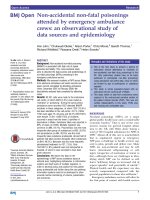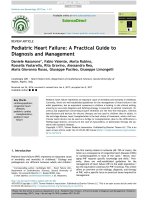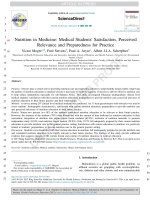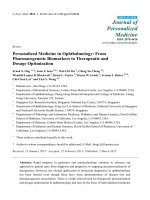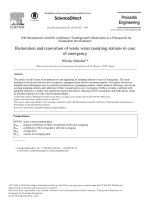Pediatric emergency medicine trisk 3965 3965
Bạn đang xem bản rút gọn của tài liệu. Xem và tải ngay bản đầy đủ của tài liệu tại đây (70.62 KB, 1 trang )
The perichondrium is primarily responsible for the strength of the proximal
femoral physis. SCFE differs from a displaced Salter I fracture in that the
perichondrium remains intact in most cases of SCFE and is disrupted with acute
Salter I fractures. Collagenous bridges that traverse the physeal cartilage and the
undulating convexity of the physis toward the epiphysis contribute to the shear
strength across the physis. Children with more vertically inclined physeal angles
have greater shear stress across their proximal femoral physes and therefore are at
greater risk for SCFE. Although it takes an enormous shearing force to produce
acute slippage of an initially normal hip joint, the viscoelasticity of the physeal
cartilage allows for gradual slippage. Most children with acute presentations will
also have radiographic evidence of chronic slippage.
SCFE is classified by symptom duration, stability, and degree of displacement.
Patients with acute SCFE have symptoms for less than 3 weeks; with chronic
SCFE, symptoms are present for more than 3 weeks. Acute-on-chronic SCFE
describes patients with symptoms for more than 3 weeks with a recent
exacerbation. An acute slip with severe symptoms is unstable. Acute or chronic
slips with mild symptoms are stable and have a more favorable prognosis.
SCFE is idiopathic in about 95% of cases. Endocrine disorders,
hypothyroidism in particular, renal failure and radiation therapy are risk factors
for “atypical SCFE.” Children outside the usual age range for SCFE, children
with valgus displacement of the femoral epiphysis, and those with other signs and
symptoms that suggest possible endocrine abnormalities should be referred for
endocrine evaluation.
Clinical Considerations
Clinical Recognition
Pain and/or limp are the most common chief complaints in patients with SCFE.
Physicians may be misled when the pain is referred to the groin, thigh, or knee
which occurs in over 40% of cases.
Triage
The presence of limp or hip pain and the potential for SCFE is rarely an emergent
condition. These patients should remain nonambulatory as continued weight
bearing may exacerbate the slip. The presence of fever in the setting of hip pain
or limp would not be consistent with SCFE but may suggest a septic arthritis or
osteomyelitis and therefore warrants a higher triage level.
Initial Assessment/H&P
